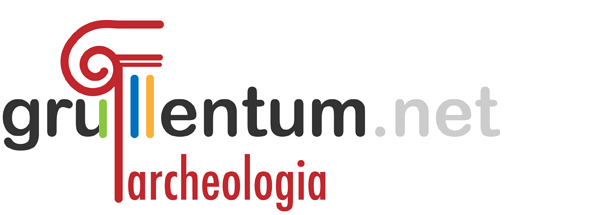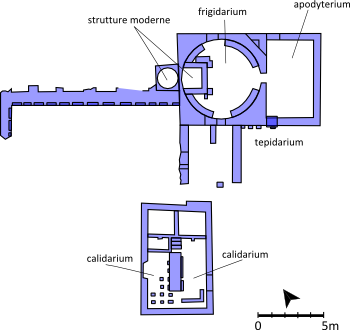The Republican thermaeby Antonio Capano
In Roman cities was very common the practice to attend the thermal baths, for various reasons. First of all, keep thermal baths (in particular a series of heated rooms) was quite expensive in terms of fuel; secondly, it was necessary a considerable availability of space inside the domestic wall, that the vast majority of the city’s inhabitants couldn’t afford. That’s why it was often much more practical and cheap the use of public baths (as we nowadays attend swimming pools) which, in addition to the baths, offer open spaces to be used as gyms and areas where practice physical activities. Many Roman cities, including Grumentum, have thermae of Republican era (such as these described here) and thermal baths successively built, of Imperial age. The so-called Republican thermae of Grumentum, are located east of the forum, and overlook the eastern decumanus of the city. Today are incorporated in rural small houses that until fifty years ago served as wine vat, that are structures with tanks where was trod grapes and the must was left to ferment: after the rearrangement of the Archaeological Park, in the late 90’s, the “Republican thermae” have been included in the museum, in the area of restaurant and bookshop.
The mosaic of calidarium has a pattern with large frame decorated in Greek style that contains another frame with a two head cable on dark background (pattern very similar to that one in mosaics of the mansion in locality Maiorano in Viggiano), in which are depicted panels with stylized four-petals flowers, dating between the fourth and fifth century A.C., and rhombus patterns, always on dark background, separated in the middle by a long lanceolata leaf dark on light background: comparisons in Trifernum dating back to the first century A.C. The four-leaf clover in square frame is also present in the mansion of Cugno dei Vagni, in Nova Siri, and is dated to the second century A.C. A comparison of the Greek pattern in panel black on light background is present just in Grumentum, in the mosaic paving of the southern triclinium in the Domus of mosaics, dated back between the late third and early fourth century A.C., while in the lararium-nymphaeum mosaic of the Domus we can find decoration in panels of four-petals and cables, dating to the second century A.C. To north of the calidarium there was the tepidarium, partially excavated, from which was possible to access to the frigidarium, of circular shape, with seats on the sides, paved in opus spicatum, that means with cutting bricks. The room was connected to east with the apodyterium (changing room), of rectangular shape, and to south with the tepidarium. The water supply was guaranteed by the urban water channel network served by the aqueduct, and the water was collected in a cistern in front of the structural complex. The thermal baths had been working at least until the epoch of Severan emperors, since the discovery of a celebrative base dedicated to Divine Severus, but the presence of African pottery in the stratigraphic context suggests that the complex was working until the fifth-sixth century A.C., that means more or less until the abandonment of the city.
Copyright text and images (where there aren't other references) by Antonio Capano
|




 The structure is in
The structure is in